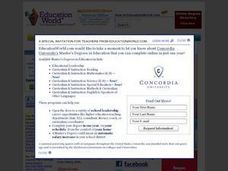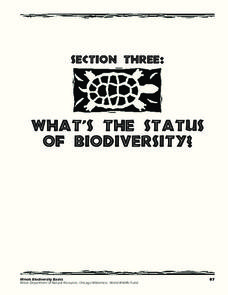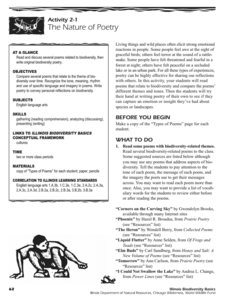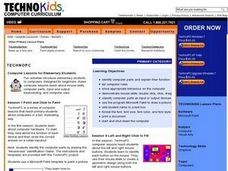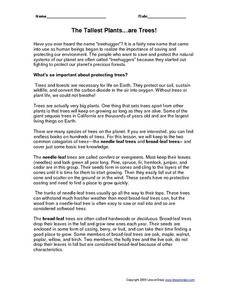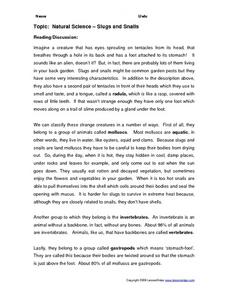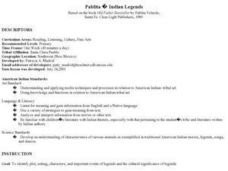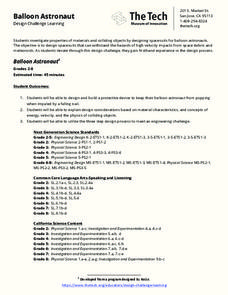Curated OER
Crater Creation
After looking at the back of a quarter featuring Oregon terrain, learners distinguish between fiction and non-fiction and identify the beginning, middle and end of a story. First, they listen to legends that describe the creation of...
Indiana Department of Education
Indiana K-12 Educators’ Resource Toolkit
Imagine a tool that magically engages readers in the classroom. A handbook for Indiana educators doesn't guarantee success, but it does offer a variety of strategies for teachers to try. The handbook opens with research-based theory...
Curated OER
Note Taking By Crayon
Skim a brief biography of Amelia Earhart with your class, and then assign groups of researchers one of four topics listed: Amelia's family life, important airplane flights during Amelia's life, turning points in Amelia's life, and...
Illinois Department of Natural Resources
Section Three: What's the Status of Biodiversity?
Biodiversity is essential for every habitat, but many species are at risk due to pollution and other factors. Explore several different species native to Illinois in a gallery walk with posters that learners have created after research...
Disney
Where Do Brown Bears Live?
What do brown bears in Alaska's Katmai National Park need to survive? Pupils explore the unique habitats, diet, and survival needs of this animal. They predict the consequences of removing any integral part of the bear's survival,...
New York State Department of Environmental Conservation
Adaptations – Designs for Survival
What's the difference between behavioral adaptations and physical adaptations? Learn about the various ways that organisms adapt to their environment with a worksheet about the creatures of the Hudson River.
Pace University
Water Cycle
Rain, rain, go away—wait, there it is again! Elementary scientists learn how rain works its way through the stages of the water cycle with a series of classroom lessons and hands-on activities.
Illinois Department of Natural Resources
Section Two: Why is Biodiversity Important?
Explore soil, genetic traits, natural resources, and pollution in a series of lessons that focus on biodiversity. Kids complete experiments to learn more about the importance of varied genes and organisms in an ecosystem.
Have Fun Teaching
Growing Seeds (9)
A seed, water, and sunlight. A seed, water, but no sunlight. A seed, sunlight, but no water. Young biologists are ask to infer what will happen to seeds given five different growing conditions.
Alabama Wildlife Federation
Seed Necklace
Seeds come in many colors, shapes, and sizes—and that variety makes for a great necklace! Young learners collect a variety of seeds during their search in a nature area. An adult then prepares the seeds to better thread them onto a cord,...
Curated OER
Celebrating Groundhog Day with your Students
Celebrating Groundhog Day in your classroom is a fun-filled way to explore science, art, and literature.
Curated OER
Art to Zoo: Celebration
Students research and develop a report on birthday rituals around the world. In this research lesson plan, students compare birthday rituals from other cultures to their own. Images and resources are included.
Curated OER
Do the Hokey Pokey in Many Languages
Young scholars replace the body part words in the tune The Hokey Pokey with the same body part words in other languages. They learn the vocabulary more readily because of the connection to music.
Curated OER
Techno PC: Computer Lessons for Elementary Students
Students explore computer science by participating in mini activities. In this graphic design lesson, identify the different components on a personal computer and define their purpose. Students utilize Microsoft Paint to create a digital...
Kelly's Kindergarten
Kelly's Kindergarten: Names of Planets
Need some helpful images for your astronomy unit? Check out a slide show that hosts several pictures of planets with their names.
Curated OER
Setting's Effect on a Character's Actions
Do the actions of a character in a story change based on the setting the writer provides? Learners explore the concept of character action in relation to story setting by investigating the setting and events in the story Science...
Curated OER
Reading "Beetles, Bees and Butterflys"
Reading information about beetles, bees, and butterflies is the focus of this science worksheet. Students apply vocabulary and comprehension skills in order to answer six questions based on the reading.
Curated OER
The Tallest Plants ... are Trees!
A fabulous worksheet about trees awaits your students. They read a lengthy selection on the various parts of trees, then complete 13 fill-in-the-blank and matching questions about what they have read. An excellent reading comprehension...
Curated OER
Slugs and Snails
Slugs and snails are the focus of this life science worksheet. Student read a selection on these animals, then answer ten comprehension questions. Then, students must draw an "alien portrait" using the characteristics of slugs and snails...
Curated OER
A Picture Is Worth at Least One Word
Learners explore clip art pictures to create a rebus. In this clip art lesson plan, students define what a rebus is and then create their original rebuses. Learners use clip art from the computer to design their rebuses.
Curated OER
Fable Writing--Inter-disciplinary Approach To Social Sciences
Students recognize the elements of a fable and write an original fable. They make connections with morals and other law-related concepts.
Curated OER
Pablita Indian Legends
Scholars are introduced to the characteristics of a legend. They read and discuss Old Father Story Teller by Pablita Velarde. Then, in groups, they write and illustrate a poem based on one of the legends from the book. This lesson plan...
Tech Museum of Innovation
Balloon Astronaut
Design protection from high-speed particles. The STEM lesson plan highlights why astronauts need protection from space debris. Pupils use the design process to design, build, and test a spacesuit that will protect a balloon from a...
Curated OER
Locate Key Information in Nonfiction Text
Interpret nonfiction text with your class. Readers use key information found in nonfiction text to answer questions and problem solve. They utilize the chapter headings, diagrams, glossary, maps, and captions as well as the table of...


